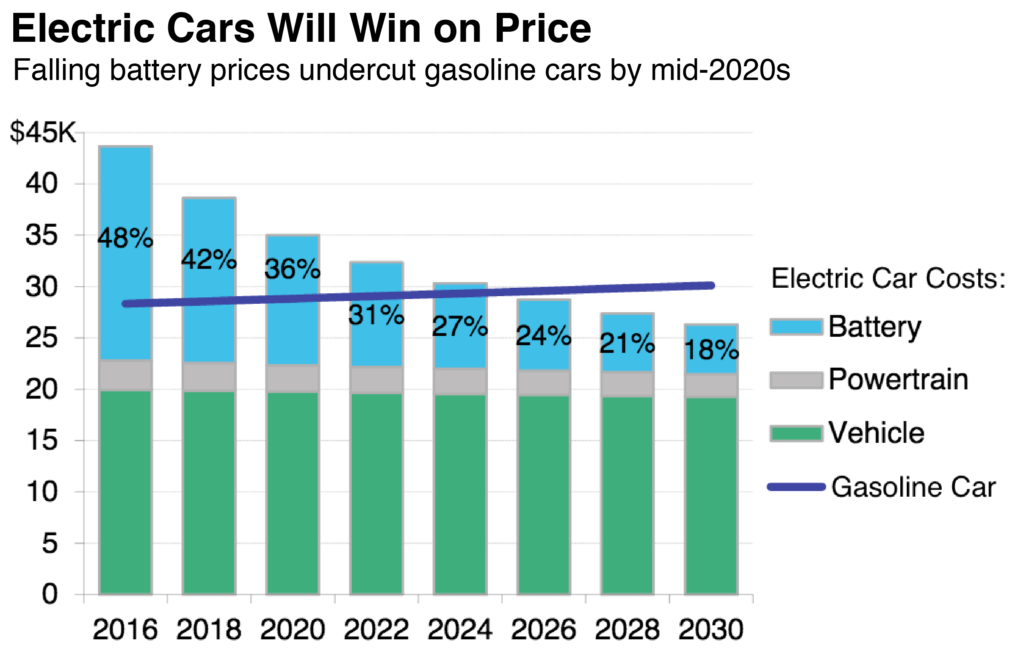... in de toekomst.
Een uitgebreide studie waar de dan vele voertuigbatterijen als buffer en balancing van het stroomnet kunnen dienen:
Citaat:
https://ilsr.org/report-electric-vehicles/
Making the Grid More Efficient
As a large new source of electricity demand, electric vehicles can cut transportation-related pollution and give grid managers unprecedented ability to make the electricity system more efficient.
Timed charging of electric vehicles means afternoon surges in electricity demand can be smoothed out (shown right) by steadily increasing demand from electric cars.
Additionally, electric cars can soak up excess energy supply by charging overnight to absorb surplus wind energy, as shown in the following chart from the Midwest Independent System Operator.

|
De meeste E-voertuigen gaan nutteloos ergens geparkeerd staan tijdens de dag als het stroomnet ze goed kan gebruiken. Overdag kunnen ze ook met zonne-energie opgeladen worden.
En laat in de nacht kunnen ze gebruikt worden om windenergie op te slaan, want dan is de stroomvraag het kleinste.
Citaat:
Finally, electric cars can support the basic balancing act of the grid by adjusting their charging levels second-to-second in order to maintain a steady voltage and frequency (a practice called “ancillary services”). Taking advantage of this power will require new market rules, but vehicles with nothing more than a Level 2 charger could provide valuable services to the grid, often able to respond more quickly than than existing power sources.
Enabling Energy Democracy
Electric vehicles can crucially expand the opportunity and capacity for local energy production and resiliency. Like solar, electric cars are a conspicuous way to burnish an owner’s environmental or self-reliance bona fides and to save money. But the combination of the “sexy electrics” — solar and electric cars — is also a marriage of complementary technologies, an increasingly inexpensive power source and a flexible power user. Individuals can fuel their vehicle using sun from their rooftop. Communities can generate more solar locally by putting more of that power to use at home, to power vehicles. The following graphic illustrates how electric vehicles could absorb daytime solar energy, enabling more homes and businesses to go solar without requiring grid upgrades.

Finally, electric vehicles can provide resilient power to communities under threat of severe weather or natural disasters, since today’s electric vehicles already have enough battery power to run an average American home for 24 hours.
|
De E-wagen zal enkel al qua aankoopprijs gunstiger worden dan een benzine vanaf 2025
(TCO nu al, maar dan met premies, na 2020 zullen er wslk geen premies meer gegeven worden, behalve in landen die achter staan of waar het nog nodig is):

Ik vat enkel wat samen wat in die studie staat.
Uiteraard zal dit voor de meeste E-voertuigen bijna dagelijks het geval zijn, begin dus aub niet te zagen dat men 400 km per dag rijdt ofzo, over x%-uitzonderingen en lange trips gaat het
niet.
De studie heeft er gemakshalve de gemiddelde verplaatsingen bijgezet en
een ijkpunt van een zeer bescheidene E-wagen, in de toekomst
gaat het gemiddeld rijbereik minstens verdubbelen, en gaat men nog meer batterijcapaciteit als buffer kunnen gebruiken:
Citaat:

With today’s electric vehicles already able to cover most drivers’ daily travel needs, and generally able to refuel completely each night, the extended range of next-generation electric cars will all but eliminate the issue of “range anxiety.” A recent test drive of a pre-production Chevy Bolt found it exceeded the EPA-listed range of 238 miles on a drive along the California coast. Cross-country travel may still require fewer stops with a gas-powered car in 2020, but too few Americans routinely travel long distance to sufficiently affect the overall adoption of electric vehicles in the near term.
|
Qua duurzaamheid gaan de batterijen van de toekomst ook gemakkelijk 5000-10000?* volledige cycles halen (in de regel onverslijtbaar), maar bij buffering/balancing zal maar een miniem deel van een volledige cyclus gebruikt worden. De batterij zal daar nauwelijks onder lijden, ttz een goedkopere stroomprijs compenseert dat volledig.
*3 jaar geleden sprak men al van 10.000 cyclussen tot 90% restcapaciteit:
https://insideevs.com/ornl-solid-sta...-10000-cycles/
zelfs als we het halveren is dit ongelooflijk...